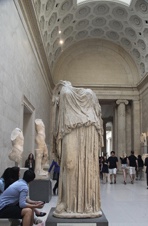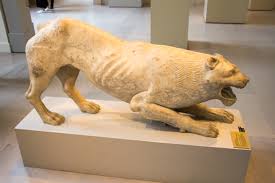Michael Cefalo
ARTD 1010 – 9:30 AM
Professor Shaw
Final Essay
Is Everything Connected?
Throughout the monumental span of history that our world has traversed through, we along with every other inhabitant have evolved a great deal. However not only have we undergone massive changes, but so has the art and sculptures produced during our ever-changing timeline. Looking back on what we have not only learned during the course of our semester but to the pieces that the Met Museum holds home to, we can begin to notice a similar trend in both the statues and art pieces. One might just play the thought off as a simple coincidence, a mere inspiration related incident that drove many pieces to follow the same trend. But if delved into deeper we can truly begin to see morsels of something greater that could be at play, something that in turn can tie everything we’ve seen throughout the last few months, and everything’s that’s been created during the last millennium, together.
Starting us off the beaten path are the sculptures I had seen at the Met. The statue of Eirene, the marble statue of the lion, and the bronze horse. At first read, these three pieces may seem as though they are leagues apart as if they have nothing to do with each other and were just made for the sake of it. And yes, that could very well be the case and they may not at all tie together, but with the information gathered about them, the times they were created, the place they originate from, and the backstories that spin their tales, we are able to weave together some loose points, giving us a pretty clear comparison. To start off, we have the piece known as the Bronze Horse. The Bronze Horse was the epitome of elegance, as it portrayed the Greeks use of Geometric art to create a wonderfully stylized piece. From this, the Greeks had begun to grow their art of creation and began to advance what they already could do. Transferring over to the piece known as the Marble Lion, we can see a clear-cut comparison. This statue usually sat guard at tombs of people with great importance, supposedly protecting them in both the mortal world and afterlife. It took the base model of the Bronze Horse and expanded on it, creating a full torso of a very realistic looking lion in a motion pose. Moving forward to the last statue I had observed from the Met, we have the Statue of Eirene. She, just as the lion, was created from a marble base (but had originally been created with a bronze base just as the Bronze Horse). Portrayed to be a goddess (daughter of Zeus and Themis), she was one of three maidens and was most closely associated with the fertility of the earth and the nurturing of children. Already closely relating to the previous two statues from the exhibit in terms of their surreal natures, they also relate in the fact that all three of them originate from Greece, and can be connected by either the product used to create them or through the form they take once completed. Though this is just the start of how each of them truly forms together. Although the may have proved to be base models for each other, they also turned out to be base models for the start of an artistic uprise in the early Roman empire. Each of these pieces were front-runners in inspiration for artists in Rome, as they had gathered pointers from each of these statues to create art in their fashion.
Upon gathering information from these three works of art and how they connect to create a much bigger picture, it is clear to see that many distinct art styles as well as sculptures tend to follow a certain “guideline” per say, or gather information from each other to create and evolve over a span of time. We have seen this many times over throughout the semester, and by doing so, I was able to incorporate that knowledge along with newfound information gathered from the Met and websites to fully conclude the ever so lingering question of if everything was truly connected. Although this may seem like a vague explanation of something that may have seemed bigger, it is, in fact, the key to unlocking a whole world of new views and methods of answering this question. It provides the baseline systemic method to follow whilst walking down this road of ever lingering questions, and the ways to solve them. Overall this was a very intriguing question to follow as a last hoorah to the wonderful semester and was made much clearer with the help of every topic gone over throughout the course.



Works Cited
The Met’s Heilbrunn Timeline of Art History, www.metmuseum.org/art/collection/search/247173.
The Met’s Heilbrunn Timeline of Art History, www.metmuseum.org/art/collection/search/248140.
The Met’s Heilbrunn Timeline of Art History, www.metmuseum.org/art/collection/search/251050.
David, Ariel. “Linking the Past and the Present Through Art.” The New York Times, The New York Times, 7 Sept. 2010, www.nytimes.com/2010/09/08/arts/08iht-rartisrael.html.
The Met’s Heilbrunn Timeline of Art History, www.metmuseum.org/blogs/teen-blog/renaissance- portrait/blog/studying-art-from-the-past.


